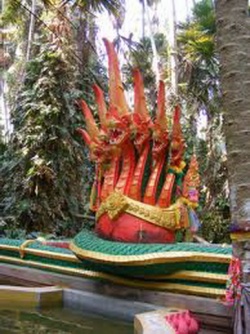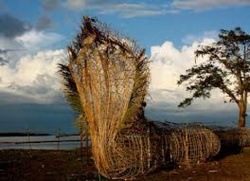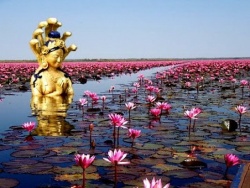Difference between revisions of "Nāgā"
m (Text replacement - "fulfilment" to "fulfilment") |
|||
| (8 intermediate revisions by 4 users not shown) | |||
| Line 1: | Line 1: | ||
[[File:147ges.jpg|thumb|250px|]] | [[File:147ges.jpg|thumb|250px|]] | ||
| − | 1. Nāgā | + | 1. [[Nāgā]] |
| − | Chief woman disciple of [[Sujāta Buddha]]. J.i.38; Bu.xiii.26. | + | Chief woman [[disciple]] of [[Sujāta Buddha]]. J.i.38; Bu.xiii.26. |
| − | + | ---------------<br/> | |
| − | 2. Nāgā | + | 2. [[Nāgā]] |
One of the chief women supporters of [[Phussa Buddha]]. Bu.xix.21. | One of the chief women supporters of [[Phussa Buddha]]. Bu.xix.21. | ||
| + | ---------------<br/> | ||
| + | 3. [[Nāgā]] | ||
| − | + | A former [[birth]] of Asokamālā, when she was the wife of [[Tissa]] (later [[Sāliya]]), an artisan of Mundagangā. MT.605. | |
| − | + | ---------------<br/> | |
| − | A former birth of Asokamālā, when she was the wife of Tissa (later Sāliya), an artisan of Mundagangā. MT.605. | + | 4. [[Nāgā]] [[Therī]] |
| − | |||
| − | 4. | ||
| − | |||
| − | |||
| + | An [[Arahant]] of Bhātaragāma. During the pillage of [[Brāhmana]] [[Tissa]], when all the villagers had fled, she went with her [[colleagues]] to a banyan [[tree]], the presiding [[deity]] of which provided them with [[Food]]. She had a brother, [[Nāga]]; when he visited her she gave him part of her [[Food]], but he refused to accept [[Food]] from a [[Bhikkhuni]]. MA.i.546; AA.ii.654. | ||
| + | ---------------<br/> | ||
5. [[Nāga]] | 5. [[Nāga]] | ||
| − | An eminent Therī of Ceylon. Dpv.xviii.35. | + | An {{Wiki|eminent}} [[Therī]] of [[Ceylon]]. Dpv.xviii.35. |
| − | + | ---------------<br/> | |
| − | 6. | + | 6. [[Nāgā]] |
| − | |||
| − | |||
| − | 7. Nāgā | + | A woman who lived near the Rājāyatana-cetiya. Once, [[seeing]] sixty [[monks]] return from the village with [[empty]] [[bowls]], she, although already pledged to work by day, borrowed some [[money]] on promise to work at night as well, and gave them [[Food]]. The [[monks]] retired to Mucalindavana and developed [[arahantship]] before eating. The [[deity]] of the king's [[parasol]] shouted applause, and the [[king]], having [[heard]] the story, gave [[Nāgā]] the whole island, which thus came to be called [[Nāgā]][[dipa]]. Ras.ii.16f. |
| + | ---------------<br/> | ||
| + | 7. [[Nāgā]] | ||
[[File:Ima123.jpg|thumb|250px|]] | [[File:Ima123.jpg|thumb|250px|]] | ||
| − | A class of beings classed with Garulas and Supannas and playing a prominent part in Buddhist folk lore. They are gifted with miraculous powers and great strength. Generally speaking, they are confused with snakes, chiefly the hooded Cobra, and their bodies are described as being those of snakes, though they can assume human [[Form]] at will. They are broadly divided into two classes: those that live on land (thalaja) and those that live on water (jalaja). The Jalaja-nāgā live in rivers as well as in the sea, while the Thalaja-nāgā are regarded as living beneath the surface of the earth. Several [[Nāga]] dwellings are mentioned in the [[Books]]: e.g., | + | A class of [[beings]] classed with [[Garulas]] and [[Supannas]] and playing a prominent part in [[Buddhist]] {{Wiki|folk}} lore. They are gifted with miraculous [[powers]] and great strength. Generally {{Wiki|speaking}}, they are confused with {{Wiki|snakes}}, chiefly the hooded {{Wiki|Cobra}}, and their [[bodies]] are described as {{Wiki|being}} those of {{Wiki|snakes}}, though they can assume [[human]] [[Form]] at will. They are broadly divided into two classes: those that [[live]] on land (thalaja) and those that [[live]] on [[water]] (jalaja). The Jalaja-nāgā [[live]] in [[rivers]] as well as in the sea, while the Thalaja-nāgā are regarded as living beneath the surface of the [[earth]]. Several [[Nāga]] {{Wiki|dwellings}} are mentioned in the [[Books]]: e.g., |
<poem> | <poem> | ||
Mañjerika-[[Bhavana]] under [[Sineru]], | Mañjerika-[[Bhavana]] under [[Sineru]], | ||
| − | Daddara-[[Bhavana]] at the foot of Mount Daddara in the Himālaya, | + | Daddara-[[Bhavana]] at the foot of Mount Daddara in the [[Himālaya]], |
| − | the Dhatarattha-nāgā under the river Yamunā, | + | the Dhatarattha-nāgā under the [[river]] {{Wiki|Yamunā}}, |
| − | the Nābhāsā Nāgā in Lake Nabhasa, | + | the Nābhāsā [[Nāgā]] in [[Lake]] Nabhasa, |
| − | and also the Nāgas of Vesāli, Tacchaka, and Payāga (D.ii.258). | + | and also the [[Nāgas]] of [[Vesāli]], Tacchaka, and Payāga (D.ii.258). |
</poem> | </poem> | ||
| − | The [[Vinaya]] (ii.109) contains a list of four royal families of Nāgas (Ahirājakulāni): Virūpakkhā, Erāpathā, Chabyāputtā and Kanhagotamakā. Two other [[Nāga]] tribes are generally mentioned together: the Kambalas and the Assataras. It is said (SA.iii.120) that all Nāgas have their young in the Himālaya. | + | The [[Vinaya]] (ii.109) contains a list of four {{Wiki|royal}} families of [[Nāgas]] (Ahirājakulāni): Virūpakkhā, Erāpathā, Chabyāputtā and Kanhagotamakā. Two other [[Nāga]] tribes are generally mentioned together: the Kambalas and the Assataras. It is said (SA.iii.120) that all [[Nāgas]] have their young in the [[Himālaya]]. |
| − | Stories are given - e.g., in the Bhūridatta [[Jātaka]] - of Nāgas, both male and female, mating with humans; but the offspring of such unions are watery and delicate (J.vi.160). The Nāgas are easily angered and passionate, their [[Breath]] is poisonous, and their glance can be deadly (J.vi.160, 164). They are carnivorous (J.iii.361), their diet consisting chiefly of frogs (J.vi.169), and they sleep, when in the world of men, on ant hills (ibid., 170). The enmity between the Nāgas and the Garulas is proverbial (D.ii.258). At first the Garulas did not know how to seize the Nāgas, because the latter swallowed large stones so as to be of great weight, but they learnt how in the Pandara [[Jātaka]]. The Nāgas dance when music is played, but it is said (J.vi.191) that they never dance if any Garula is near (through fear) or in the presence of human dancers (through shame). | + | Stories are given - e.g., in the [[Bhūridatta]] [[Jātaka]] - of [[Nāgas]], both {{Wiki|male}} and {{Wiki|female}}, mating with [[humans]]; but the offspring of such unions are watery and delicate (J.vi.160). The [[Nāgas]] are easily angered and [[passionate]], their [[Breath]] is {{Wiki|poisonous}}, and their glance can be deadly (J.vi.160, 164). They are carnivorous (J.iii.361), their [[diet]] consisting chiefly of frogs (J.vi.169), and they [[sleep]], when in the [[world]] of men, on ant hills (ibid., 170). The [[enmity]] between the [[Nāgas]] and the [[Garulas]] is proverbial (D.ii.258). At first the [[Garulas]] did not know how to seize the [[Nāgas]], because the latter swallowed large stones so as to be of great weight, but they learnt how in the [[Pandara]] [[Jātaka]]. The [[Nāgas]] dance when {{Wiki|music}} is played, but it is said (J.vi.191) that they never dance if any Garula is near (through {{Wiki|fear}}) or in the presence of [[human]] dancers (through [[shame]]). |
[[File:870_n.jpg|thumb|250px|]] | [[File:870_n.jpg|thumb|250px|]] | ||
| − | The best known of all Nāgas is Mahākāla, king of Mañjerika-[[Bhavana]]. He lives for a whole kappa, and is a very pious follower of [[ | + | The best known of all [[Nāgas]] is [[Mahākāla]], [[king]] of Mañjerika-[[Bhavana]]. He [[lives]] for a whole [[kappa]], and is a very pious follower of The [[Buddha]]. The [[Nāgas]] of his [[world]] had the custodianship of a part of the [[Buddha's relics]] till they were needed for the Māha [[Thūpa]] (Mhv.xxxi.27f.), and when the [[Bodhi tree]] was {{Wiki|being}} brought to [[Ceylon]] they did it great honour during the voyage (Mbv. p.. 163f.). Other [[Nāga]] [[kings]] are also mentioned as ruling with great [[Power]] and majesty and {{Wiki|being}} converted to The [[Buddha]]'s [[Faith]] - e.g., Aravāla, Apalālā, Erapatta, [[Nandopananda]], and Pannaka. (See also Ahicchatta and Ahināga.) In the [[Atānātiya]] [[Sutta]] (D.iii.198f.), {{Wiki|speaking}} of dwellers of the Cātummahārajika [[world]], the [[Nāgas]] are mentioned as occupying the {{Wiki|Western}} Quarter, with Virūpokkha as their [[king]]. |
| + | |||
| + | The [[Nāgas]] had two chief settlements in [[Ceylon]], in Nāgadīpa (q.v.) and at the {{Wiki|mouth}} of the [[river]] Kalyānī. It was to settle a dispute between two [[Nāga]] chiefs of Nāgadīpa, [[Mahodara]] and [[Cūlodara]], that The [[Buddha]] paid his second visit to [[Ceylon]]. During that visit he made a promise to another [[Nāga]]-[[king]], Manjakkhika of Kalyānī, to pay him a visit, and The [[Buddha]]'s third visit was in fulfilment of that {{Wiki|undertaking}} (Mhv.i.48f.). | ||
| − | The Nāgas | + | The [[Nāgas]] [[Form]] one of the guards set up by [[Sakka]] in [[Sineru]] against the [[Asuras]] (J.i.204). The [[Nāgas]] were sometimes worshipped by [[human beings]] and were [[offered]] sacrifices of milk, {{Wiki|rice}}, {{Wiki|fish}}, meat and strong drink (J.i.497f.). The [[jewel]] of the [[Nāgas]] is famous for its [[Beauty]] and its [[Power]] of conferring wishes to its possessor (J.vi.179, 180). |
| − | The | + | The [[word]] [[Nāga]] is often used as an [[Epithet]] of The [[Buddha]] and the [[Arahants]], and in this connection the {{Wiki|etymology}} given is āgum na karotī ti Nāgo (e.g., MNid.201). The [[Bodhisatta]] was born several times as [[king]] of the [[Nāgas]]: [[Atula]], [[Campeyya]], [[Bhūridatta]], Mahādaddara, and Sankhapāla. |
| − | + | In the accounts given of the [[Nāgas]], there is undoubtedly great [[confusion]] between the [[Nāgas]] as [[supernatural]] [[beings]], as {{Wiki|snakes}}, and as the [[name]] of certain non [[Aryan]] tribes, but the [[confusion]] is too difficult to unravel. | |
| − | |||
| − | |||
{{R}} | {{R}} | ||
[http://www.palikanon.com/english/pali_names/n/nagaa.htm www.palikanon.com] | [http://www.palikanon.com/english/pali_names/n/nagaa.htm www.palikanon.com] | ||
[[Category:Buddhist Terms]] | [[Category:Buddhist Terms]] | ||
| − | [[Category: | + | [[Category:Nagas]] |
Latest revision as of 12:52, 9 February 2016
1. Nāgā
Chief woman disciple of Sujāta Buddha. J.i.38; Bu.xiii.26.
2. Nāgā
One of the chief women supporters of Phussa Buddha. Bu.xix.21.
3. Nāgā
A former birth of Asokamālā, when she was the wife of Tissa (later Sāliya), an artisan of Mundagangā. MT.605.
An Arahant of Bhātaragāma. During the pillage of Brāhmana Tissa, when all the villagers had fled, she went with her colleagues to a banyan tree, the presiding deity of which provided them with Food. She had a brother, Nāga; when he visited her she gave him part of her Food, but he refused to accept Food from a Bhikkhuni. MA.i.546; AA.ii.654.
5. Nāga
An eminent Therī of Ceylon. Dpv.xviii.35.
6. Nāgā
A woman who lived near the Rājāyatana-cetiya. Once, seeing sixty monks return from the village with empty bowls, she, although already pledged to work by day, borrowed some money on promise to work at night as well, and gave them Food. The monks retired to Mucalindavana and developed arahantship before eating. The deity of the king's parasol shouted applause, and the king, having heard the story, gave Nāgā the whole island, which thus came to be called Nāgādipa. Ras.ii.16f.
7. Nāgā
A class of beings classed with Garulas and Supannas and playing a prominent part in Buddhist folk lore. They are gifted with miraculous powers and great strength. Generally speaking, they are confused with snakes, chiefly the hooded Cobra, and their bodies are described as being those of snakes, though they can assume human Form at will. They are broadly divided into two classes: those that live on land (thalaja) and those that live on water (jalaja). The Jalaja-nāgā live in rivers as well as in the sea, while the Thalaja-nāgā are regarded as living beneath the surface of the earth. Several Nāga dwellings are mentioned in the Books: e.g.,
Mañjerika-Bhavana under Sineru,
Daddara-Bhavana at the foot of Mount Daddara in the Himālaya,
the Dhatarattha-nāgā under the river Yamunā,
the Nābhāsā Nāgā in Lake Nabhasa,
and also the Nāgas of Vesāli, Tacchaka, and Payāga (D.ii.258).
The Vinaya (ii.109) contains a list of four royal families of Nāgas (Ahirājakulāni): Virūpakkhā, Erāpathā, Chabyāputtā and Kanhagotamakā. Two other Nāga tribes are generally mentioned together: the Kambalas and the Assataras. It is said (SA.iii.120) that all Nāgas have their young in the Himālaya.
Stories are given - e.g., in the Bhūridatta Jātaka - of Nāgas, both male and female, mating with humans; but the offspring of such unions are watery and delicate (J.vi.160). The Nāgas are easily angered and passionate, their Breath is poisonous, and their glance can be deadly (J.vi.160, 164). They are carnivorous (J.iii.361), their diet consisting chiefly of frogs (J.vi.169), and they sleep, when in the world of men, on ant hills (ibid., 170). The enmity between the Nāgas and the Garulas is proverbial (D.ii.258). At first the Garulas did not know how to seize the Nāgas, because the latter swallowed large stones so as to be of great weight, but they learnt how in the Pandara Jātaka. The Nāgas dance when music is played, but it is said (J.vi.191) that they never dance if any Garula is near (through fear) or in the presence of human dancers (through shame).
The best known of all Nāgas is Mahākāla, king of Mañjerika-Bhavana. He lives for a whole kappa, and is a very pious follower of The Buddha. The Nāgas of his world had the custodianship of a part of the Buddha's relics till they were needed for the Māha Thūpa (Mhv.xxxi.27f.), and when the Bodhi tree was being brought to Ceylon they did it great honour during the voyage (Mbv. p.. 163f.). Other Nāga kings are also mentioned as ruling with great Power and majesty and being converted to The Buddha's Faith - e.g., Aravāla, Apalālā, Erapatta, Nandopananda, and Pannaka. (See also Ahicchatta and Ahināga.) In the Atānātiya Sutta (D.iii.198f.), speaking of dwellers of the Cātummahārajika world, the Nāgas are mentioned as occupying the Western Quarter, with Virūpokkha as their king.
The Nāgas had two chief settlements in Ceylon, in Nāgadīpa (q.v.) and at the mouth of the river Kalyānī. It was to settle a dispute between two Nāga chiefs of Nāgadīpa, Mahodara and Cūlodara, that The Buddha paid his second visit to Ceylon. During that visit he made a promise to another Nāga-king, Manjakkhika of Kalyānī, to pay him a visit, and The Buddha's third visit was in fulfilment of that undertaking (Mhv.i.48f.).
The Nāgas Form one of the guards set up by Sakka in Sineru against the Asuras (J.i.204). The Nāgas were sometimes worshipped by human beings and were offered sacrifices of milk, rice, fish, meat and strong drink (J.i.497f.). The jewel of the Nāgas is famous for its Beauty and its Power of conferring wishes to its possessor (J.vi.179, 180).
The word Nāga is often used as an Epithet of The Buddha and the Arahants, and in this connection the etymology given is āgum na karotī ti Nāgo (e.g., MNid.201). The Bodhisatta was born several times as king of the Nāgas: Atula, Campeyya, Bhūridatta, Mahādaddara, and Sankhapāla.
In the accounts given of the Nāgas, there is undoubtedly great confusion between the Nāgas as supernatural beings, as snakes, and as the name of certain non Aryan tribes, but the confusion is too difficult to unravel.


